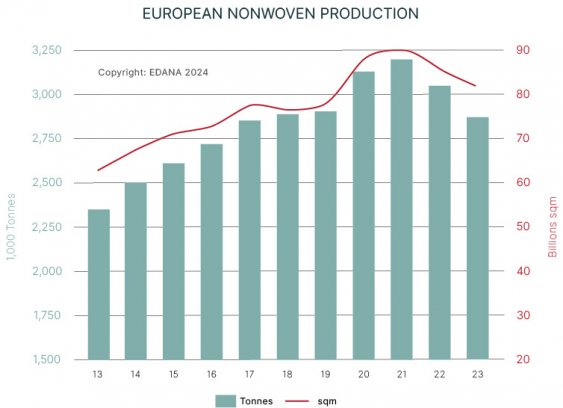
EDANA actions for nonwovens industry against COVID-19
Demand continues to fall in many end-use sectors from 2021 peak.

12th April 2024
Innovation in Textiles
|
Brussels
Nonwovens production in Greater Europe fell in volume by 5.7% to 2,864,840 tons in 2023 compared to 2022, and by 5.5% in surface area, resulting in 81.7 billion square metres of nonwovens being manufactured.
This is the key finding of the latest EDANA Statistics Report produced by the Brussels-basesd nonwovens association.
Differing trends were observed at the national level when comparing production between countries, and also when assessing the various nonwoven production processes and market segments.
“European nonwovens production recorded its second consecutive decline since it peaked in 2021, but it is necessary to refine the data further and assess the trends according to the different production processes,” says Jacques Prigneaux, EDANA’s market analysis and economic affairs director. “For drylaid, the production of thermally and chemically bonded nonwovens both saw a double-digit decline. The production of polymer-based nonwovens also fell again, but remained above its 2019 level, despite a severe decrease in meltblown stand-alone materials. Meanwhile, some production processes, such as drylaid-hydroentangled and short-fibres airlaid, stayed flat or slightly above their respective levels for 2022.
“If we consider sales both within and outside Europe, segments such as hygiene, medical – other than face masks – building construction, filtration, and electronic materials decreased significantly compared to their 2022 levels, but were either at the same level as or above figures observed in 2019. Overall, the wipes market, including personal care, industrial and household segments, was stable (+0.9%) and there were some noticeable exceptions in other applications, where nonwovens sales recovered.”
These include automotive interiors (+3.7%), agriculture (+7.7%), table linen (+4.2%), cotton pads (+6.8%), personal protective garments (+10%) and packaging (+9.5%).
“Trends for surface area data can be different, as the product’s weight is also important,” Prigneaux adds. “As a result, EDANA’s figures in square metres continue to provide our member companies with important information every year.”
An increased membership base combined with continuous monitoring of the industry makes EDANA’s statistics a valuable business tool for all of its member companies across the nonwovens value chain. The data is not shared externally, but Prigneaux will present an overview of the key findings at the inaugural EDANA Innovation Forum in Munich, Germany in June 2024. In the meantime, a summary report – 2023 European Nonwovens Markets Insights – will be made available soon for EDANA members.

Business intelligence for the fibre, textiles and apparel industries: technologies, innovations, markets, investments, trade policy, sourcing, strategy...
Find out more